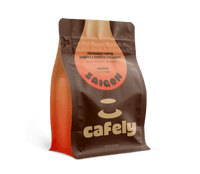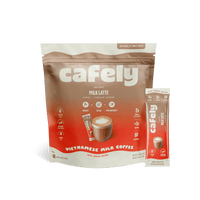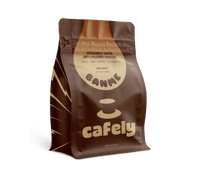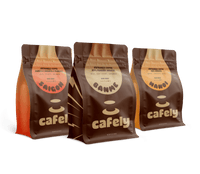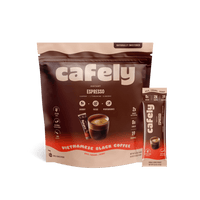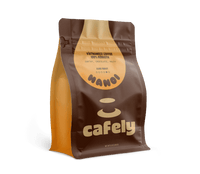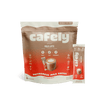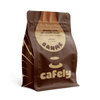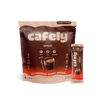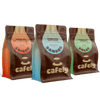The FDA recommends that we limit our caffeine intake to no more than 400 mg of caffeine per day [27]. This is like drinking four 8-oz cups of regular coffee daily.

However, if you’re also consuming other caffeinated food products on top of your daily cuppas, you might already be exceeding the daily limit without even realizing it.
We’ve gathered some of the popular caffeinated products in the market in this post so you’d be more aware of your caffeine intake.
Caffeine in Coffee
There are many factors that affect the caffeine levels in coffee. These include:
- Roasting Process: Light roasted and medium roasted coffee beans typically contain more caffeine than dark roasted coffee beans.
- Variety of Coffee Beans: Different coffee beans have different levels of caffeine. For example, our 100% robusta HaNoi Coffee contains around twice as much caffeine as a typical arabica coffee.
- Brewing Method: The brewing method also influences the caffeine content, with espresso machines extracting more caffeine than French presses.
- Type of Coffee: Decaffeinated coffee, brewed coffee, instant coffee, espresso, and Vietnamese coffee all contain different amounts of caffeine.
- Serving Size: A cup of coffee can be anywhere from 1 oz (espresso shot) to 24 oz. Generally, the larger the coffee’s serving size, the higher its caffeine content.
Roasting Processes
Caffeine remains relatively stable throughout the entire roasting process of the green coffee beans. However, light and medium roasts tend to have more caffeine than dark roasts [4].
Light roasted coffee also retains more of its chlorogenic acid than medium and dark roasts. Chlorogenic acid is the compound that helps give coffee its flavors and aroma.

The roasting temperature and the amount of compounds left in the beans after roasting affect the way they look, smell, and taste. They also influence the beans’ acidity levels.

Variety of Coffee Beans
The most common types of coffee beans you’ll see in the market are arabica and robusta. Of the two, robusta contains the most caffeine.
On average, robusta beans have twice the caffeine content of arabica beans. Arabica beans have a 1.09% caffeine content, while it’s 2.09% in robusta beans [30].
However, Vietnamese robusta coffee, like Cafely’s BanMe, has a higher caffeine content (around 2.7%) than regular robusta beans.

On average, an 8-oz cup of robusta coffee (whole beans) has 1.7 times higher caffeine levels than a cup of arabica coffee. Robusta Instant coffees also have 1.5 times more caffeine than arabica instant coffees.
If you’re looking for a strong caffeine fix without the jitters and the shakes, Cafely’s got you covered. Its whole and ground beans contain 120 to 150 mg of caffeine per serving. Its Instant Vietnamese Black Coffee also has 150 mg of caffeine per cup.

Brewing Method
One study looked at the effects of eight brewing or extraction methods on caffeine levels and found that specialty espresso machines extract eight times more caffeine than French press. However, there’s not a lot of difference between the efficacy of classic and specialty espresso machines in extracting caffeine [2].

Types of Coffee
The type of coffee drink determines how much caffeine is in a cup. Here’s a breakdown of caffeine levels for the most common kinds of coffee drinks and an explanation of their caffeine levels.

Vietnamese Coffee
Vietnamese coffee is typically made using a traditional phin filter. The water moves through the ground coffee and drips into the cup.
It’s also brewed using robusta coffee beans, which have around twice as much caffeine as the standard arabica beans in most other coffee drinks. This is why Vietnamese coffee has so much higher caffeine content compared to other coffee drinks of the same size.
There are six popular types of Vietnamese coffee, each with varying levels of caffeine. The strongest Vietnamese coffee is Cà Phê Phin, which is simply drip coffee using a Phin filter.

Related: Why is Vietnamese Coffee So Strong?
Espressos, Lattes, Cappuccinos, & More
You make espresso by forcing a little hot water through finely-ground coffee beans. Even though this type of coffee has more caffeine than brewed coffee, it often has less per serving, as an espresso is much smaller than a typical cold brew or French press coffee.
Espresso-based drinks, such as macchiatos, cappuccinos, and lattes, contain espresso shots mixed with varying amounts of milk. There’s no milk in caffeine, so these drinks have the same amount of caffeine as a single or double espresso, depending on how many shots there are.
Pour-Over Coffee
You make pour-over coffee by pouring hot water over ground coffee in a paper filter over a pour-over device, such as a Chemex brewer or a Hario V60. The water drips through the ground coffee, and your pour-over coffee is ready in 3–4 minutes.
The amount of caffeine in pour-over coffee depends on the type of beans used, but it’s usually a little more than an espresso.
Cold Brew Coffee
Cold brew coffee is one of the most unusual types of coffee on this list because you make it by steeping coffee grounds in cold or room-temperature water for 8–24 hours. This variety of coffee uses more coffee beans and less water than other types of coffee, increasing its caffeine levels.
Related: Cold Brew Vietnamese Coffee Recipe.
French Press
You make French press coffee by slowly pushing hot water through a metal filter to extract the nutrients, texture, and flavor. Because of the long extraction time, French press coffee is often higher in caffeine than other types, such as regular coffee and instant coffee.
Drip Coffee
Regular drip coffee is the most common type of coffee made in the US. Also known as brewed coffee, you make it by pouring hot water over ground coffee beans inside a filter. Regular coffee contains about the same amount of caffeine as instant coffee.
Instant Coffee
Instant coffee is brewed coffee that has been spray-dried or freeze-dried. It comes in large, dry pieces which quickly dissolve in boiling water. There’s no brewing involved in making instant coffee.
Just add one or two teaspoons of instant coffee into a cup, pour over hot water, and stir. Instant coffee usually contains less caffeine than other types of coffee.
Check Out Cafely’s Selection of Premium Instant Coffee.
Decaffeinated Coffee
Although the name may suggest otherwise, decaffeinated coffee does contain caffeine. A 180-mL cup of instant decaf coffee usually contains 3 mg of caffeine. Brewed decaf coffee, on the other hand, still has around 5 mg of caffeine per 180 mL cup [6].

Caffeine in Popular Coffee Brands
More than 1 in 5 (21%) Americans don’t check the Nutrition Facts panel when buying any type of food product, including coffee [20]. This habit can increase your risk of caffeine overconsumption, especially if you belong to the 32% of Americans who drink more than a cup of coffee a day [9].
As a consumer, do you know the caffeine content of your favorite coffee brands?
Whole Coffee Beans and Espresso
Barring decaf and half-caff coffee, a cup made with either whole or ground beans can, on average, contain as little as 72.5 mg to as much as 355 mg of caffeine per serving.
A cuppa with 72.5 mg of caffeine may not be enough for some to kickstart their day, but a cup with 355 mg of caffeine may also be too much for those sensitive to caffeine. Just one serving means you’ve almost reached the recommended daily limit!
If you’re after dark roast coffees with bold, robust flavors and high caffeine content, Cafely’s whole and ground beans are a good option. Made with premium-grade robusta beans, a cuppa can contain around 120 mg to 150 mg of caffeine. These beans give you just the right caffeine kick to boost your energy without making you jittery or anxious.
Pods/Capsules
A coffee pod or capsule can contain a whopping 550 mg of caffeine per serving, so if you’re after really strong cups, go for Death Wish. The caffeine content of its coffee pods and capsules typically ranges between 162.5 mg and 550 mg per serving.
Depending on your tolerance, its caffeine content can easily induce side effects such as restlessness, rapid heartbeat, and headache. It could also even trigger anxiety.
However, if you’re looking for just the right caffeine kick, Nescafe and Nespresso have some great options for you.
Are you sensitive to caffeine or just want to enjoy coffee without caffeine? Don’t worry! You’ll also find excellent decaf and half-caff coffee pods from great brands like Four Sigmatic, Nespresso, and Peet’s on our list.
Instant Coffee
Need a quick, powerful caffeine punch? Then Death Wish’s instant coffee is just your thing, with its 300 mg per 8-oz serving. Be warned though that this is already three-fourths of the recommended daily limit of 400 mg of caffeine per day.
If you want a strong, flavorful cup of instant coffee that still leaves you room for another cup or two, then try Cafely. Each serving contains around 150 mg of caffeine. This is a potent enough level to boost your energy but not trigger side effects.
Starbucks Coffee Drinks vs Dunkin’ Coffee Drinks
Starbucks and Dunkin’ are the biggest rivals in the coffeehouse chain industry, with Starbucks leading in the number of stores and sales. Starbucks has 1.7 times more stores than Dunkin and 2.4 times higher sales in 2022 [28].
But of the two, who is leading the caffeine war?
Check out the caffeine content of some of the popular hot and iced Starbucks and Dunkin’ coffee drinks below.
Caffeine in Ready-to-Drink Beverages
Nearly half (47%) of Americans who drink coffee consume well within the limit of no more than four cups of coffee per day [9].
But if you love your daily cuppas and a few other caffeinated beverages on the side, you just might be exceeding the recommended limit.
Let’s see exactly how much caffeine these popular caffeinated drinks contain.
Ready-to-Drink (RTD) Coffee
RTD coffees typically come in single-serve cans or bottles, but you’ll also find some in multi-serve bottles. These are convenient and perfect for a quick pick-me-up.
But be mindful of the amount you drink!
Barring decaf RTDs, one serving can contain as much as 300 mg of caffeine per 8 fl oz (237 mL), which already puts you three-fourths of the way to the daily caffeine limit, or as little as 6 mg per 12 fl oz (360 mL).
Caffeinated Water
Caffeinated water comes in single-serves and RTD bottles or drops, powders, and tablets that you add to water for multiple servings. Some are also infused with flavorings and other beneficial compounds such as ginseng, guarana, electrolytes, and vitamins.
Caffeinated water (liquid form) can contain as high as 180 mg per serving or as low as 30 mg of caffeine per serving. Those that you add to water also have almost the same caffeine content, ranging from 30 mg to 200 mg of caffeine per serving.
These refreshing drinks can give your energy a quick boost. But your daily cups of coffee plus a few servings of caffeinated water can put you beyond the daily limit.
Sodas
Crowd-favorite Pepsi and Coca-Cola sodas contain anywhere from 34 mg to 38 mg of caffeine per serving, and it’ll take you around 10 to 12 cans to reach the daily limit. But there are highly-caffeinated sodas too, and drinking four servings puts you beyond the daily limit.
Mountain Dew Kickstart, for example, has 90 mg of caffeine per serving, and it’s the leading soda with the highest caffeine content per serving on our list. Fritz Kola Original (EU) and Nitro Pepsi land in second and third places, with 82.5 mg and 77 mg of caffeine per serving, respectively. The caffeine from your daily coffee and a can or two of these can quickly add up and result in overconsumption.
Energy Drinks
A can or bottle of energy drink can easily push you nearer the recommended daily caffeine limit, with a caffeine content ranging anywhere from 75 mg to 316 mg per serving.
Take VPX Redline Xtreme’s energy drink, for example. One 8-oz bottle of this highly potent energy drink contains 316 mg of caffeine. That’s already more than three cups of regular coffee!
But that’s for an 8 fl oz bottle, though. Some products on our list contain more caffeine in a smaller serving size.
Check out 5-Hour Energy. Its selection of extra-strength energy drinks contains a whopping 230 mg of caffeine per 1.93 fl oz bottle.
You need to be extra careful with energy drinks. One serving often comes loaded with caffeine, which can easily put you at a very high risk of overconsumption.
Caffeine in Tea
Several factors affect the caffeine levels in tea. These include:
- Brewing Temperature: The higher the temperature, the more caffeine is extracted from the tea leaves.
- Length of Brewing Time: The longer the brewing or steeping time, the more caffeine is also extracted from the leaves. But steeping tea for an hour or more can degrade caffeine, reducing its content.
- Types of Tea: Fully oxidized teas like black tea contain more caffeine than minimally oxidized teas like pu-erh.
Brewing Temperature and Steeping Time
A study investigated the effects of brewing temperature on caffeine extraction and found that higher brewing temperature extracts more caffeine than low temperatures [1].
A longer steeping time also extracts more caffeine than a shorter steeping time. However, steeping the tea leaves at a high temperature for longer than 30 minutes may result in lower caffeine levels. This may be because prolonged exposure to heat and water can speed up the degradation process of caffeine.

Caffeine in Tea Leaves
Green tea, black tea, oolong tea, white tea, and pu-erh tea all come from the same plant — the Camellia sinensis plant — and are called the True Teas. However, they differ in the type of leaves used as well as fermentation, oxidation, and processing methods. T hese factors not only influence their aroma and flavor but their caffeine content as well.
Of the True Teas, oolong and black teas have the highest caffeine content. These teas use mature leaves which naturally contain more caffeine than younger leaves. White and green teas have the lowest caffeine levels, and these use young leaves. Pu-erh tea has an almost negligible level of caffeine [5]. One reason for this may be that the leaves lose more of their caffeine content as they age. Plus, the long processing and aging time could strip away even more caffeine.
Yerba mate contains 80 mg of caffeine per 150-mL serving. This type of tea isn’t considered a True Teas since it uses the dried leaves from the yerba mate tree [12].
Herbal teas are a type of tea that uses fruits, flowers, herbs, and spices. Unlike yerba mate tea or the True Teas from Camellia sinensis,herbal teas don’t contain caffeine.
Caffeine in Popular Teabags
Teabags may seem small, but one packet can contain as much as 95 mg of caffeine per serving, which is already equivalent to a shot of espresso. But like coffee, you can also enjoy tea without caffeine, and some of the products on our list are actually decaf and contain zero caffeine.
Did you know though that people used to brew a whole pot of tea using loose leaves? When the teabag was invented in 1901, it quickly became the most popular way of brewing tea [11]. You only need to use one bag to make a cup, compared to brewing a whole pot and wasting the rest of the tea if you only want a drink or two.
Today, teabags remain the most popular method of making tea in the US. More than 1 in 2 tea drinkers (51%) prefer using teabags compared to the 4% who prefer loose leaf [16].
Caffeine in Ready-to-Drink Teas
A serving of ready-to-drink tea can contain as low as 7 mg of caffeine per 12 fl oz (360 mL) serving or as high as 180 mg of caffeine per 15.5 fl oz (458 mL) serving. The latter’s like drinking two cups of coffee!
If you’re after potent RTD teas, check out Rehab Monster’s collection, and for zero caffeine, Zevia, Tazo Tea, and Honest Tea have great products to choose from.
Caffeine in Tea Pods
Compatible with most Nespresso and K-Cup coffeemakers, tea pods give you a convenient and easy way to brew tea. These are premeasured, so you’re assured of consistent brews.
Although decaffeinated, decaf tea pods usually still have around 3.5 mg of caffeine per serving. But if you’re after strong tea pods, check out Mad Tea’s selection, with a caffeine content ranging from 100 mg to 135 mg of caffeine per serving.
Herbal and fruit teas, of course, contain zero caffeine since their sources typically don’t produce caffeine.

Caffeine in Instant Tea
One serving of instant tea can contain anywhere from as little as 3 mg of caffeine per serving to as much as 105 mg of caffeine per serving.
Of those on our list, Kalustyan's has the highest caffeine content, its instant masala green and black tea powders having around 105 mg and 75 mg of caffeine per serving.
For low-caffeine options, Whittard gives you a good list of instant teas with different flavors, such as sour cherry, apple, lychee and rose, and pink lemonade.

Caffeine in Caffeinated Desserts
Caffeinated sweets and desserts are fun, delicious ways to get your caffeine fix, but they’re also very easy to overconsume. You probably won’t notice any effects after a piece or two. But if you continue indulging in them in one sitting, the caffeine could easily pile up.
So, which sweets contain the most caffeine?
Caffeine in Quick Energy Products
These caffeinated products on our list provide a quick energy boost to enhance alertness, focus, and performance. They’re also good sources of energy to quickly replace those lost during training and competitions.
These products usually come in small servings and are pretty easy to overconsume. For example, a 7 g caffeine gummy could contain 100 mg of caffeine — that’s a shot espresso right there!
If you regularly take them, be sure to monitor your intake so you don’t exceed the 400 mg caffeine daily limit. You can also try caffeine gummies with lower caffeine content, like Cafely’s, which have around 75 mg per piece. These give you a potent boost in energy and lower risk of jitters and shakes.
Caffeine in Common Drugs
Caffeine tablets contain high amounts of caffeine, of course. But did you know that weight loss products and common over-the-counter drugs like Excedrin and Midol also contain caffeine?
Take Hydroxycut Hardcore Weight Loss’, for example. One serving contains a high caffeine content of 265 mg. And you’re OTC painkillers? They have around 120 mg to 130 mg per pill or capsule.
Health Benefits of Caffeine
There are many studies on caffeine's effects on the human body. And good news, coffee drinkers!
Multiple scientific papers report that moderate amounts of caffeine may offer several health benefits, including:
- Boosting mood [23]
- Improving brain function [13]
- Increasing metabolism [3]
- Lowering the risk of heart disease [29]
- Reducing the risk of stroke [17]
- Protecting against diabetes [15]
- Lowering the risk of liver damage [25]
- Decreasing the chance of premature death [18]
- Reducing the risk of cancer [26]
- Preventing gout [8]
- Boosting beneficial gut bacteria [14]
These health benefits are in addition to the common advantages that almost everyone enjoys when drinking coffee. Caffeine is a natural stimulant, and as little as 66 mg can help you feel awake, alert, and ready to go.
Related: Is Vietnamese Coffee Healthy?
Side Effects of Caffeine
Caffeine is generally considered safe, although consumption can become a habit. The US Food and Drug Administration (USFDA) and the European Food Safety Authority (EFSA) recommend up to 400 mg of caffeine per day [10,27]. This is the equivalent of two to four cups.
Consuming more caffeine than this per day can result in some side effects, such as:
- Anxiety [22]
- Difficulties sleeping [21]
- Headaches and migraines [31]
- High blood pressure [24]
- Pregnancy complications [7]
Limit yourself to a maximum of four cups per day to avoid any potential negative side effects of caffeine. Pregnant women should consume no more than 200 mg per day [19]. This is around one to two cups.
Related: How to Stop Heart Palpitations From Caffeine
FAQs: Caffeine Content in Coffee
Have some more questions? Here are the answers to the most common questions about how much caffeine is in coffee.
1. What Type of Coffee Has the Most Caffeine?
Per volume, espresso has the most caffeine. Per coffee drink, cold brew has the most caffeine. The type of coffee drink, variety of coffee beans, roast of coffee beans, size of coffee drink, and brewing method all influence how much caffeine in coffee.
2. Is Caffeine Good for You?
Studies show there are many potential health benefits to consuming caffeine in coffee. It can help you feel more alert and awake while lowering your risk of disease and cancer. At the same time, it can increase your metabolism, boost your brain function, and improve your mood.
3. How Much Caffeine is Too Much?
The USFDA and the EFSA agree that you shouldn’t consume more than 400 mg of caffeine per day. This is two to four cups. Limiting your coffee intake to this amount may help you avoid the negative side effects of consuming too much caffeine.
4. Does Decaffeinated Coffee Contain Caffeine?
Yes, decaffeinated coffee does contain caffeine, although the quantities are minimal. An 8 oz cup of decaf coffee has 0–7 mg of caffeine. As long as you don’t have a severe allergy or intolerance to caffeine, decaffeinated coffee is safe for most people to consume when avoiding caffeine.
5. Can You Build a Tolerance to Caffeine?
Yes, you can build a tolerance to caffeine over time.
Factors that influence caffeine tolerance include:
- Frequency of consumption
- Caffeine dose
- Body weight
- Age
Regular consumption, high caffeine doses, higher body weight, and older age make you less sensitive to caffeine. You’d need to increase your coffee consumption to feel the same effects you get from previous cups.
The good news is you can “reset” your tolerance by taking a caffeine break for a week or two or decreasing your daily consumption.
References
- Allameh, M., & Orsat, V. (2023). Optimization of extraction conditions for the maximum recovery of L‐theanine from tea leaves: Comparison of black, green, and white tea. JSFA Reports, 3(12), 655–662.
- Angeloni, G., Guerrini, L., Masella, P., Bellumori, M., Daluiso, S., Parenti, A., & Innocenti, M. (2019). What kind of coffee do you drink? An investigation on effects of eight different extraction methods. Food Research International, 116, 1327–1335.
- Antonio, J., Newmire, D. E., Stout, J. R., Antonio, B., Gibbons, M., Lowery, L. M., Harper, J., Willoughby, D., Evans, C., Anderson, D., Goldstein, E., Rojas, J., Monsalves-Álvarez, M., Forbes, S. C., Lopez, J. G., Ziegenfuss, T., Moulding, B. D., Candow, D., Sagner, M., & Arent, S. M. (2024). Common questions and misconceptions about caffeine supplementation: what does the scientific evidence really show? Journal of the International Society of Sports Nutrition, 21(1), 2323919.
- Awwad, S., Issa, R., Alnsour, L., Albals, D., & Al-Momani, I. (2021). Quantification of Caffeine and Chlorogenic Acid in Green and Roasted Coffee Samples Using HPLC-DAD and Evaluation of the Effect of Degree of Roasting on Their Levels. Molecules (Basel, Switzerland), 26(24), 7502.
- Boros, K., Jedlinszki, N., & Csupor, D. (2016). Theanine and Caffeine Content of Infusions Prepared from Commercial Tea Samples. Pharmacognosy Magazine, 12(45), 75.
- Cappelletti, S., Daria, P., Sani, G., & Aromatario, M. (2015). Caffeine: Cognitive and Physical Performance Enhancer or Psychoactive Drug? Current Neuropharmacology, 13(1), 71–88.
- Chen, L., Wu, Y., Neelakantan, N., Chong, M. F., Pan, A., & Van Dam, R. M. (2014). Maternal caffeine intake during pregnancy is associated with risk of low birth weight: a systematic review and dose-response meta-analysis. BMC Medicine, 12, 174.
- Choi, H. K., & Curhan, G. (2010). Coffee consumption and risk of incident gout in women: the Nurses’ Health Study. The American Journal of Clinical Nutrition, 92(4), 922–927.
- Daily Survey: Coffee. (2022). YouGov.
- EFSA NDA Panel (EFSA Panel on Dietetic Products, Nutrition and Allergies). (2015). Scientific Opinion on the safety of caffeine. EFSA Journal, 13(5), 4102.
- Eschner, K. (2016). Ever Wonder Who Invented the Tea Bag? Smithsonian Magazine.
- Gawron-Gzella, A., Chanaj-Kaczmarek, J., & Cielecka-Piontek, J. (2021). Yerba Mate—A Long but Current History. Nutrients, 13(11), 3706.
- Heckman, M. A., Weil, J., & De Mejia, E. G. (2010). Caffeine (1, 3, 7-trimethylxanthine) in Foods: A Comprehensive Review on Consumption, Functionality, Safety, and Regulatory Matters. Journal of Food Science, 75(3), R77–R87.
- Jaquet, M., Rochat, I., Moulin, J., Cavin, C., & Bibiloni, R. (2009). Impact of coffee consumption on the gut microbiota: A human volunteer study. International Journal of Food Microbiology, 130(2), 117–121.
- Jiang, X., Zhang, D., & Jiang, W. (2014). Coffee and caffeine intake and incidence of type 2 diabetes mellitus: a meta-analysis of prospective studies. European Journal of Nutrition, 53, 25–38.
- Kunst, A. (2020). Preference for tea bags or loose tea in the U.S. 2019. Statista.
- Larsson, S. C., & Orsini, N. (2011). Coffee Consumption and Risk of Stroke: A Dose-Response Meta-Analysis of Prospective Studies. American Journal of Epidemiology, 174(9), 993–1001.
- Lopez-Garcia, E., Van Dam, R. M., Li, T. Y., Rodriguez-Artalejo, F., & Hu, F. B. (2008). The Relationship of Coffee Consumption with Mortality. Annals of Internal Medicine, 148(12), 904–914.
- Moderate daily caffeine intake during pregnancy may lead to smaller birth size. (2021). National Institutes of Health (NIH).
- Nearly 80 percent of U.S. adults used Nutrition Facts panel on food labels in buying decisions. (2023). Economic Research Service (ERS).
- O’Callaghan, F., Muurlink, O., & Reid, N. (2018). Effects of caffeine on sleep quality and daytime functioning. Risk Management and Healthcare Policy, 11, 263–271.
- Reissig, C. J., Strain, E. C., & Griffiths, R. R. (2009). Caffeinated energy drinks—A growing problem. Drug and Alcohol Dependence, 99(1–3), 1–10.
- Richards, G., & Smith, A. (2015). Caffeine consumption and self-assessed stress, anxiety, and depression in secondary school children. Journal of Psychopharmacology, 29(12), 1236–1247.
- Riksen, N. P., Rongen, G. A., & Smits, P. (2009). Acute and long-term cardiovascular effects of coffee: Implications for coronary heart disease. Pharmacology & Therapeutics, 121(2), 185–191.
- Saab, S., Mallam, D., Cox, G. A., & Tong, M. J. (2013). Impact of coffee on liver diseases: a systematic review. Liver International, 34(4), 495–504.
- Sang, L., Chang, B., Li, X., & Jiang, M. (2013). Consumption of coffee associated with reduced risk of liver cancer: a meta-analysis. BMC Gastroenterology, 13, 34.
- Spilling the Beans: How Much Caffeine is Too Much? (2023). US Food and Drug Administration (FDA).
- Statista Research Department. (2023). Sales of leading coffee shop chains US 2022. Statista.
- Wu, J., Ho, S. C., Zhou, C., Ling, W., Chen, W., Wang, C., & Chen, Y. (2009). Coffee consumption and risk of coronary heart diseases: A meta-analysis of 21 prospective cohort studies. International Journal of Cardiology, 137(3), 216–225.
- Zainuri, N., Paramartha, D. N. A., Fatinah, A., Nofrida, R., Rahayu, N., Anggraini, I. M. D., & Utama, Q. D. (2023). The Chemical Characteristics of Arabica and Robusta Green Coffee Beans. BIOTROPIA, 30(3), 318–328.
- Zduńska, A., Cegielska, J., Zduński, S., & Domitrz, I. (2023). Caffeine for Headaches: Helpful or Harmful? A Brief Review of the Literature. Nutrients, 15(14), 3170.
